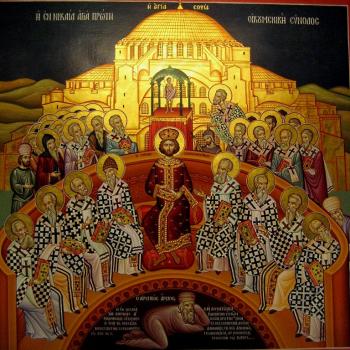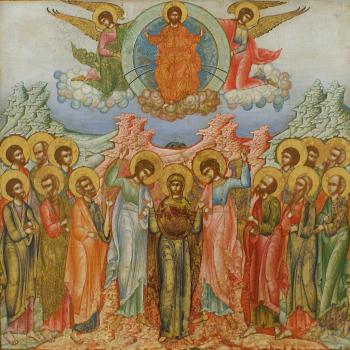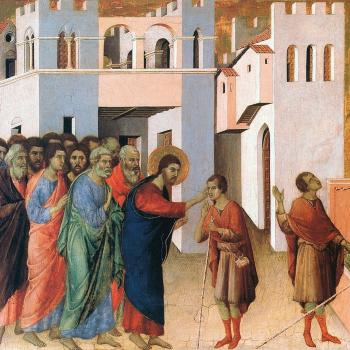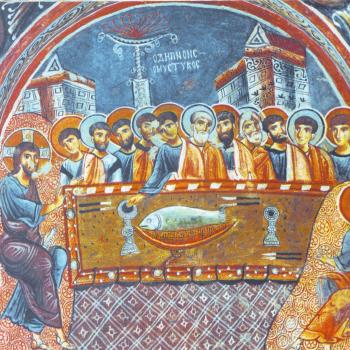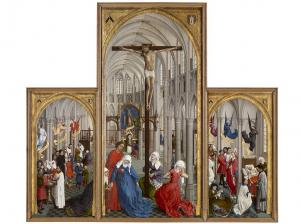
Jesus, through his life, death, and resurrection, constantly touched the world at large, transfiguring it with his grace. His blood poured down from the cross. A tomb was made from the rock. He was laid down to his sabbath rest in the earth. Then he rose from the dead, transforming and deifying all things. The earth and all that is upon it is called to share in the glory of God. All of creation has been affected by the incarnation, as all creation finds itself transfigured by Christ, being transformed not only into something new, but greater than it was before. God became man, and therefore, a creature, so that all of creation can find its place in the kingdom of God.
The sacraments should remind us of the transformative work of the God-Man. Through him, the waters of the world have become a vessel for purification and grace. Bread and wine, fruit of the earth and vine, are taken in by Christ as he transforms them into his body and blood. The Son, sending the Spirit into the world, uses oil to anoint us, making it the means by which the Spirit itself can be shared, indeed, the means by which we become Spirit-bearers with him.
Matter is important. Despite being ontologically next to nothingness, it remains in the realm of being, and so has a place in the eschatological kingdom of God. The Gnostics disputed the value of matter, saying that it was evil, made by an evil creator who imprisoned spiritual sparks of the good God within it. The Gnostics believed that salvation required these sparks being set free from their material bonds, allowing them to return to the transcendent God from which they came.
The teaching of the incarnation reverses such a Gnostic ideology. The incarnation does not see matter as evil. It does not see matter as a prison. True, the relationship between spirit and matter might have become disordered due to sin, but that does not make matter evil or something to be rejected. The spirit which is tied to matter in life is to be tied to matter for eternity. Thus, Jesus gave us the sacraments, revealing to us that matter contains a spiritual dimension which can and will be used for our own good. Matter is not what imprisons us: our sins do. The harm done by sin must be repaired, not by further disjointing the relationship between the spiritual and physical aspects of our being, but by reuniting them in a proper harmony.
This is what we learn from the sacraments: matter can be for us a vessel for grace because matter itself can be rendered holy. Matter is not to be despised. It is in this respect we can begin to see why Sergius Bulgakov taught that the earth itself should be seen as the holy grail, as that which takes up Christ’s body and blood, preserving it but also using it for the restoration of all created nature. Those who try to distance the work of Christ from the world ignore the way he lived as a human with a human body who touched and interacted with the world at large. All of his actions, even those which were simply ordinary, simply human, such as bathing or eating, influenced the world and were a part of what he did to transfigure it. Those who have been baptized into Christ, those who have put on Christ, should see that they are meant to continue this work, continuing the transfiguration of the world, even in the most ordinary, most mundane of human activities. Mystics often see this in the process of eating, where a spiritual transformation taking place: a holy or saintly sage or mystic takes the elements of the food into themselves so that they can change it and make it and what was contained within it holy. Likewise, when Christ came into the world, he took the world into himself, into his mystical body, transforming it and making it a part of him so that it could share in his holiness.
The incarnation requires is to have a sacramental sentiment, one which is both earthly and spiritual, recognizing the interdependent relationship of the two. It is also communion based. That is, it sees that this interdependent relationship is also one of inter-dwelling, so that we realize that what affects one aspect of creation will affect the rest of creation because of the bonds which exist between them. Such a sentiment therefore looks at things in a way for the promotion of their union, seeing, that is, how all things are one in God. It opposes all theoretical ways of living, all “options” which would divide the world up, where some groups seek some pure Gnostic (and Pelagian) society separated from everyone else. Likewise, as love is the center and foundation of all authentic spirituality, a sacramental spirituality will be inclusive in nature, charitable to outsiders, indeed, it will open itself to others with great hospitality, following the example of Abraham at Mamre.
A sacramental vision of the world will see the spirit in and with matter, and matter in and with the spirit. The two are not to be divided and put into opposition against each other, but rather, for matter and spirit to be true to themselves, they need to be true with each other, integrating themselves with each other. Even those beings which are seen as pure spirits, such as angels, have a relationship with the people of the earth, directing and guiding them, often serving as the principles behind the laws of nature itself. The sacramental sentiment opposes any dualism which rejects the unity which is to exist behind creation even as it opposes any monism offers a confused, impersonal union which removes the relative distinctions between the things which exist. Such things are joined together as one without loss of the quality and character of the various parts, similar to the way we see the species of bread and wine remain in the eucharist.
A sacramental vision of the world recognizes the good of matter, the good of the world, so that we accept that it is to be transformed in Christ. We are to share in that transformative work. We are called to mediate grace to the world instead of destroying it. The world has a destiny with us. Matter has a destiny with us. We are not going to be bodiless spirits in eternity. All Gnostic rejection of the world and matter is the antithesis of Christ and the work which he accomplished in the incarnation. This is why the earliest Christian witness against the Gnostics and their docetic ideas about Christ focused on the eucharist and how it truly is the medicine of our salvation. The sacramental vision of the world opposes all those who would divide the eschaton from the world, to deny its immanence with the world because the eschaton become immanent: the Logos became flesh, entered into the depths of the earth, and then was raised and ascended into heaven, joining heaven with earth for all eternity. The sacramental vision of the world is a vision that recognizes the integral unity which God seeks to have with his creation. This sacramental vision, this sacramental sentiment, is what we need to have if we want to follow through and understand God’s goal for creation.
Stay in touch! Like A Little Bit of Nothing on Facebook




